Himachal Pradesh is an Indian state located in northern part of the country. Shimla is the capital of Himachal Pradesh. The state is known for its natural beauty. It was made as a union territory in 1950 and attained its statehood in 1971 when it was made as the 18th state of India. Himachal Pradesh means the lap of Himalayas or the abode of snow.
History of Himachal Pradesh
The history of Himachal Pradesh starts with the time of Indus Valley Civilization in 2000 B.C. Guptas, Harshavardhana, Mahmud Ghaznavi and Sikandar Lodi held supremacy over this region at various times. During the First War of Indian Independence, the rulers of Chamba, Bilaspur, Bhagal and Dhami took the sides with British and the rulers of Bushars opposed them. After the independence of India, these princely states were added to the Indian Union. The state of Bilaspur was added to Himachal Pradesh on 1st April 1954 and it became a Union Territory on 1st November 1956. According to the Punjab Reorganization Act, 1966, some parts of Punjab were added to Himachal Pradesh and the State of Himachal Pradesh was passed on 18th December 1970. The new state emerged on 25th January 1971.
Geography and Climate of Himachal Pradesh
Himachal Pradesh covers an area of 55,673 square kilometers. Most of its lands are covered by mountains. The state has Jammu and Kashmir on the north, Punjab on the west and southwest, Uttar Pradesh and Haryana on the south and Uttarakhand on the southeast and Tibet on the east.
Some of the rivers that flow through the state are Chenab, Ravi, Sutlej, Yamuna, Beas and Parbati. Some of the major lakes situated here are Renuka, Rewalsar, Khajjiar, Prashar, Mani Mahesh, Chander Tal, Suraj Tal, Kaveri, Sreolsar, Gobind Sagar and Nako. There are 32 wildlife sanctuaries here.
The climates that prevail in different parts of the state are hot and sub-humid climate, cold climate, alpine climate and glacial climate. The average temperature in summer ranges between 28 degree Celsius and 32 degree Celsius. During winter season, alpine tracts get snowfall. The average annual rainfall of Himachal Pradesh is 1469 mm.
Natural Resources of Himachal Pradesh
About 66.52% of the state is covered by forests. Among them, 1896 square kilometers is reserved forest area and 43043 square kilometers is protected forest area. Some of the trees found here are chir pine, deodar, blue pine, west Himalayan spruce, east Himalayan fir, conifer trees, sal, shisham, alders, birches, rhododendrons, etc. Many fruit bearing trees grow well here making it the fruit bowl of the country. The cultivation of flowers such as carnations, white gladiolas, marigolds, roses, chrysanthemums, lilies and tulips are also done here.
There are about 1200 bird species and 359 animal species in Himachal Pradesh. The national parks such as Great Himalayan National Park and Pin Valley National Park are created to conserve the natural flora and fauna of the region. Some of the animals commonly seen are leopard, snow leopard, musk deer, western tragopan and ghoral.
Himachal Pradesh State Map With Districts
There are 12 districts in Himachal Pradesh as of June 2012. Given below is the Himachal Pradesh state map with all 12 districts marked.
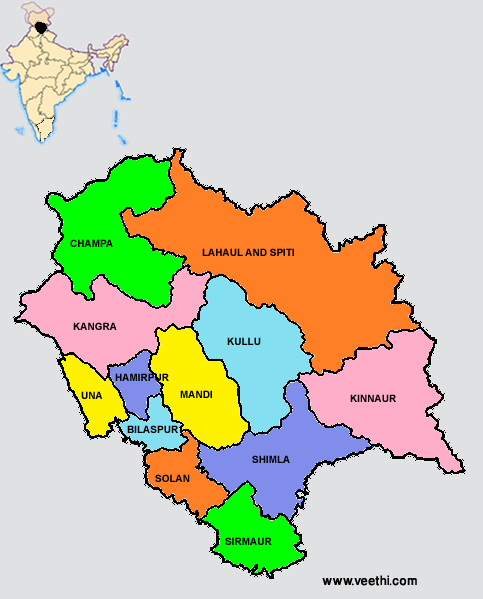
List of Districts of Himachal Pradesh
State Animal – Snow Leopard
State Bird – Western Tragopan
State Flower – Pink Rhododendron
State Tree - Deodar
State Language – Hindi and Local Dialects
People and Culture of Himachal Pradesh
The population of Himachal Pradesh as of 2011 census is 6,856,509 with a density of 123 people per square kilometers. The sex ratio is 974 female for every 1000 male. The important communities of people living here are Brahmins, Gujjars, Rathis, Saini, Rajputs, Gaddis, Ghirth, Kanets, Kolis and Jats. Hindus are the majority people and people of other religions such as Buddhism and Sikhism live here in small percentage. Hindi is the official languages though other languages like Pahar, Punjabi, Lahauli, Kulluyi, Mahasui, Gojri, Dogri, Kinnauri, Kanashi, Tukpa and Shumcho are also spoken.
The carpets, leather works, woodword, pashima shawls of Himachal Pradesh are famous throughout the country. Wool weaving is traditionally carried on by every home. The Kangra miniature paintings and local dances and festivals expose the culture of the people. Some of the food items in the Himachal Pradesh cuisine are lentil, broth, rice, bread, Pahari Aloo, Pahari Murgh, Beduan, Chutney, Khatti Dal, Sidku, Jhoul, Bhagjery, etc.
Education in Himachal Pradesh
The literacy rate of Himachal Pradesh is 83.78% with male literacy ratio of 90.83% and female literacy rate of 76.60%. This ranks second in India next only to Kerala. Some of the institutions that contribute to the higher studies are Indian Institute of Technology at Mandi, Himachal Pradesh University at Shimla, National Institute of Technology at Hamirpur, Central University at Dharamshala, Jaypee University of Information Technology at Waknaghat, SK Himachal Pradesh Krishi Vishwavidhyalya at Palampur, etc.
There are more than 10,000 primary schools and more than 1000 secondary schools and 13000 high schools in Himachal Pradesh. Indira Gandhi Medical College and Hospital and Homoeopathic Medical College and Hospital are situated within the state.
Economy of Himachal Pradesh
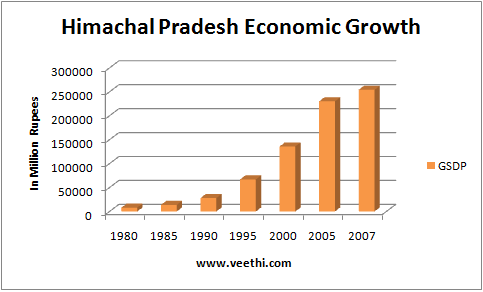
Agriculture and horticulture are the main occupations of the people of Himachal Pradesh. 45% of the net state domestic product comes from agriculture. The important crops grown here are wheat, maize, rice and barley. Himachal Pradesh is also famous for its handicrafts, carpets, pashmina shawls, embroidered chappals, Kangra and Gompa style of painting, etc.
Himachal Pradesh is noted for its hydro electric projects. 25% of the nation’s total hydro electric output comes from this state. The total GDP of the state in 2007 is 254,350 millions as per 2007. According to 2000-01, the per capita income is 10942 INR.
Himachal Pradesh Transportation
There are three domestic airports in Himachal Pradesh at Shimla, Gaggal and Bhuntar. Bhuntar Airport serves air traffic to Kullu and Manali, Gaggal Airport serves Kangra and Dharamshala. Deccan Airlines, Air India, Jagson Airlines and MDLR runs flights from Delhi and Chandigarh to Shimla.
Due to rugged terrain, not all the parts of Himachal Pradesh are connected by train. Only few railway tracks such as Pathankot, Jogindernagar line passes through the state. Shimla is connected with Kalka by narrow gauge mountain railway. The train runs through a length of 96 kilometers and passes through 102 tunnels and 864 bridges. The Bilaspur to Leh railway line is the longest in Himachal Pradesh and highest track in the world.
Among the road network of 28,208 kilometers, national highways constitute 1234 kilometers and state highways constitute 1625 kilometers. Totally there are eight national highways and 19 state highways here. Shimla is connected by road with other major cities nearby by regular bus services.
Himachal Pradesh Tourism
Tourism is one of the important sources of income of the government of Himachal Pradesh. Himachal Pradesh Tourism Development Corporation promotes tourism in the state. Some of the important places of visit in Himachal Pradesh are
1. Dalhousie
2. Shimla
3. Mandi
4. Chamba
5. Manali
6. Dharamshala
7. Rajgarh Valley
8. Sujanpur Tihra
9. Chail
10. Pragpur
11. Maharana Pratap Sagar
12. Kangra Fort
13. Great Himalayan National Park


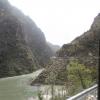
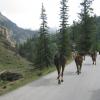
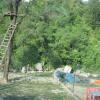
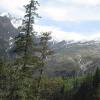
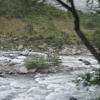
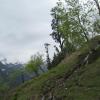
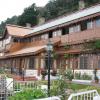
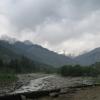
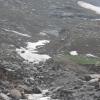
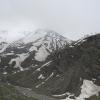











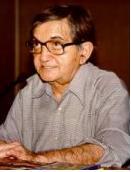

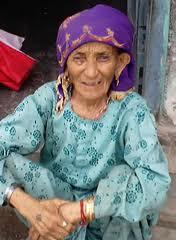


.jpeg)


